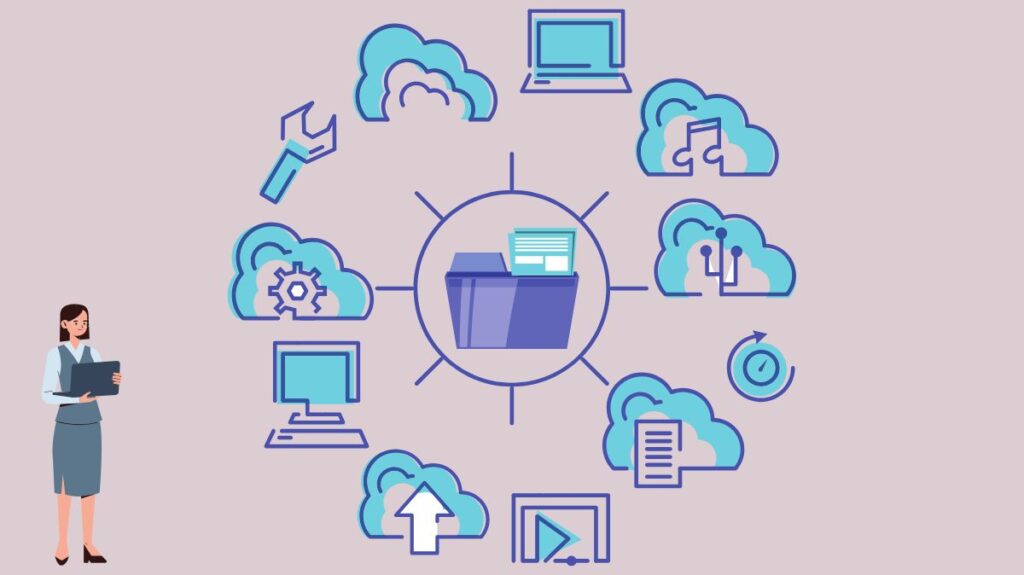Cloud Management
What is Cloud Management?
Cloud management is the systematic administration of cloud computing services and products. It describes the methods, plans, guidelines, and tools used to help manage and keep up public and private cloud, hybrid, or multicloud infrastructures.
You probably do some or all of your work on the cloud these days. Your company therefore needs a method for assessing, tracking, and effectively managing cloud computing infrastructure, services, and resources.
Many fundamental functions are necessary to keep your cloud environments functioning properly, including resource provisioning and orchestration, cloud deployment and consumption automation, resource lifecycle management, cost optimization, performance monitoring, and security.

Cloud Management definition
In public, private, or hybrid cloud systems, cloud management is the process of keeping an eye on and controlling cloud computing resources, services, and infrastructure. Control, visibility, and scalability are all made possible for IT administrators by cloud management tools and technologies, which also enable quick change adaptation.
How is cloud management implemented?
Your cloud apps and services can be deployed and operated in public, hybrid, or multicloud settings with the help of cloud management tools. In order to make well-informed decisions about how to effectively execute workloads, a competent cloud management software will also assist you in tracking and monitoring consumption and performance for every component of your cloud infrastructure.
Cloud management software and tools are typically installed as virtual machines, each of which has its own server and database. In order to interface with resources in your cloud environments, servers employ APIs. Cloud-based application activity, performance statistics, and other events can all be recorded and analysed before being combined into a single dashboard that is accessible via a web interface. Cloud administration tools are accessible from any location by administrators with a secure connection, just like your cloud resources.
The majority of cloud service providers provide cloud management as services on their own platforms, with reporting features across cloud apps to gather usage and performance statistics, produce insights, and issue notifications. However, this can lead to issues when businesses operating in a hybrid or multicloud environment need to report across various providers. Using open platforms and simple connectors, top cloud providers will also allow you to consolidate your cloud administration tools.
Why is cloud management necessary, and what is its role?
Managing hundreds or even thousands of distinct apps and servers in the cloud requires effective cloud management. Not only is doing everything by hand inefficient, but it is also impossible. Modern IT environments have made it possible for businesses to develop more quickly and scale their applications, but they have also added a great deal of complexity.
You can increase overall IT performance, enhance security, and keep expenses under control with cloud management. Some of the main advantages of cloud management are as follows:
It’s quicker to value
You spend less time on maintenance and other regular chores when you use cloud management. Throughout the entire application lifetime, self-service access for automated provisioning and deployments supports agile development to expedite delivery and lower errors.
Transparency between environments
Monitor your resources, their usage, and who has access to them using cloud management to stay ahead of cloud sprawl. It can also assist you in maximising your cloud capacity and finding the best balance for your workloads.
Controlled administration
Among other things, cloud management tools let you connect storage, operating systems, apps, and cloud security technologies. The end effect is uniform and consistent management of cost, security, compliance, and resource allocation across various clouds and settings.
Increased security and compliance
You can comply with cloud policies, guidelines, and regulatory obligations with the aid of cloud management. In order to swiftly detect infractions and other new events, administrators can also automate the monitoring of usage and configurations across environments.
Optimized expenditure on the cloud
It’s not always simple to monitor or forecast cloud spending. Detailed reports with chargeback and showback are provided by cloud management solutions to help you better evaluate consumption, allocate resources, and predict expenditures.
Sustainability in the environment
The energy consumption of your cloud infrastructure can be decreased and resource waste can be minimized with the support of cloud management.
Techniques for Cloud management
It takes more than just technology and tools to manage public, private, hybrid, or multicloud environments successfully; a solid cloud management strategy is also essential. Organizations will differ in how they develop a sound plan; you must identify the appropriate procedures, tools, and personnel to meet your company’s requirements.
A solid approach to cloud management ought to:
- Give you uniform control across environments so you may integrate and deliver services where they are most appropriate.
- Let you continuously monitor and analyse capacity, usage, prices, and security while enabling agile change management.
- Provide automated policy enforcement and security control without slowing down speed by establishing security and compliance barriers.
- Keep an eye on cloud resources and services, including charges, user changes, and violations, to identify problems early and make necessary updates to business rules and procedures.
- Although by no means comprehensive, these foundational principles are a great place to start when developing your cloud management plan.
Cloud Computing management
The management of resources and their performance is under the purview of the cloud provider. Several facets of cloud computing, including load balancing, performance, storage, backups, capacity, deployment, etc., are included in resource management. To utilize cloud resources to their best potential, management is necessary.

Tasks for Cloud Management
To guarantee effective utilization of cloud resources, the cloud provider carries out a variety of duties. We’ll talk about a few of them here:
Backups for Audit Systems
Timely backup audits are necessary to guarantee that randomly chosen files belonging to various users can be restored. The following methods can be used to perform backups:
- Storing data on company-owned discs and on-site computers, including online storage.
- File backups from the cloud provider.
If the backup is made in several places, the user has to know the specifics of those locations. It is also important to know whether the cloud provider has encrypted the data and who has access to it.
System Data Flow
The managers are in charge of creating a diagram that details a thorough process flow. The migration of an organization’s data over the cloud solution is described by this process flow.
Awareness of and Solutions for Vendor Lock-In
The management needs to be aware of how to stop using a specific cloud provider’s services. To allow cloud managers to export an organization’s data from their system to another cloud provider, protocols must be established.
Understanding the Security Protocols of the Provider
The following services’ security plans should be known by the managers:
- Use by many tenants
- Processing e-commerce
- Screening of employees
- Policy for encryption
Tracking Planning Capabilities and Scaling Capabilities
To make sure the cloud provider is meeting his company’s future capacity needs, managers need to be aware of capacity planning.
To guarantee that services can be scaled up or down under user needs, administrators must oversee the scaling capabilities.
Track the Use of Audit Logs
Regular auditing of the logs is necessary for managers to find system faults.
Validation and Testing of the Solution
It is crucial to test the solution that the cloud provider offers to make sure it produces the right outcome and is error-free. For a system to be strong and dependable, this is required.
